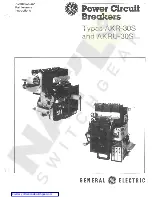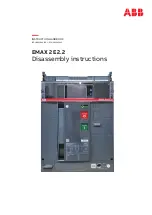
61
PowerVac
®
5kV Vertical Lift
Appendix A
The positive interlock system functions to pre-
vent closing the breaker contacts when the
breaker is being raised or lowered, and it pre-
vents raising or lowering the breaker when the
breaker contacts are closed. In most AM Breaker
Metal-Clad Switchgear units, there is a breaker
“Test Position” which allows you to function-
ally test the breaker without connecting to the
bus. This position is usually about 5 inches
from the breaker being fully lowered to the floor
of the cubicle. When in the “Test Position”, a
secondary coupler cable must be used to con-
nect the two secondary control circuits, since
the breaker is in the partially lowered position.
The lower “Vee” notch in the position interlock
cam plate, Figure 1A, allows closing and open-
ing the breaker electrically.
NOTE: FOR IMPROVED SAFETY, IT IS REC-
OMMENDED THAT THE ABILITY TO FUNC-
TIONALLY OPERATE THE BREAKER IN THE
“TEST” POSITION BE ELIMINATED AND
THAT BREAKER FUNCTIONAL TESTING BE
PERFORMED WITH THE BREAKER COM-
PLETELY REMOVED FROM THE CUBICLE.
A. By-Pass Installation.
The ability to electrically close and open the
breaker in the “Test Position” is eliminated by
covering the lower “Vee” notch in the positive
interlock cam plate. Materials for accomplish-
ing this modification are provided in Kit
#xxxxxxxxxxxx, which can be furnished as an
option, with the new vacuum breaker. This by-
pass kit can be installed on existing GE M26
magne-blast breaker cubicles that have a lower
interlock roller “Vee” notch on the positive in-
terlock cam plate. In that case, the optional by-
pass kit will be supplied. If additional by-pass
kits are required for the remainder of the
switchgear line-up cubicles, order the same kit
number.
WARNING: FAILURE TO FOLLOW THE IN-
STRUCTIONS BELOW COULD CAUSE A
CLOSED BREAKER TO BE RAISED TO-
WARDS THE CONNECTED POSITION,
CAUSING INJURY OR DEATH TO THE OP-
ERATOR AND EXTENSIVE EQUIPMENT
DAMAGE.
To make the modification proceed as follows:
1. Remove and save the existing switch
operator bracket.
2. Install the new switch operator bracket
supplied with the kit, using the two ex-
isting 1/4 - 20 screws. Adjust the bracket
in the exact same location as the re-
moved bracket, in relation to the motor
activation switch lever. Make sure that
the lower “Vee” notch in the positive
interlock cam plate is covered and that
the edge is even with the front edge of
the positive interlock cam plate. (Fig-
ure 2A and 3A).
3. Drill two 0.218 diameter holes in the posi-
tive interlock cam plate from locations
in the new bracket supplied with the kit.
See Figure 3A.
4. Install two 1/4 - 20x1/2 LG thread cut-
ting screws (supplied with the kit).
5. Install #10-24 thread cutting screws
(supplied with the kit).
6. Install existing switch operating bracket
using 1/4x20x5/8 LG hex head capscrew
with washers supplied with the kit.
7. All breaker cubicles that undergo this
modification to the positive interlock
cam plate must be checked according
the dimensions given in Figure 2A.
a. The 10-7/8” (-0” +1/16”) dimension
from the breaker to the front edge of the
positive interlock cam plate must be veri-
fied and maintained prior to inserting a
replacement VL vacuum breaker into the
cubicle. See Figure 1A.
b. The 1/16” clearance between the sta-
tionary flag, just behind the upper “Vee”
notch and the interlock roller must be
maintained or reset, if required. The
breaker should be in the fully raised
position. See Figure 1A.
POSITIVE INTERLOCK “OPTIONAL” PROCEDURES
































